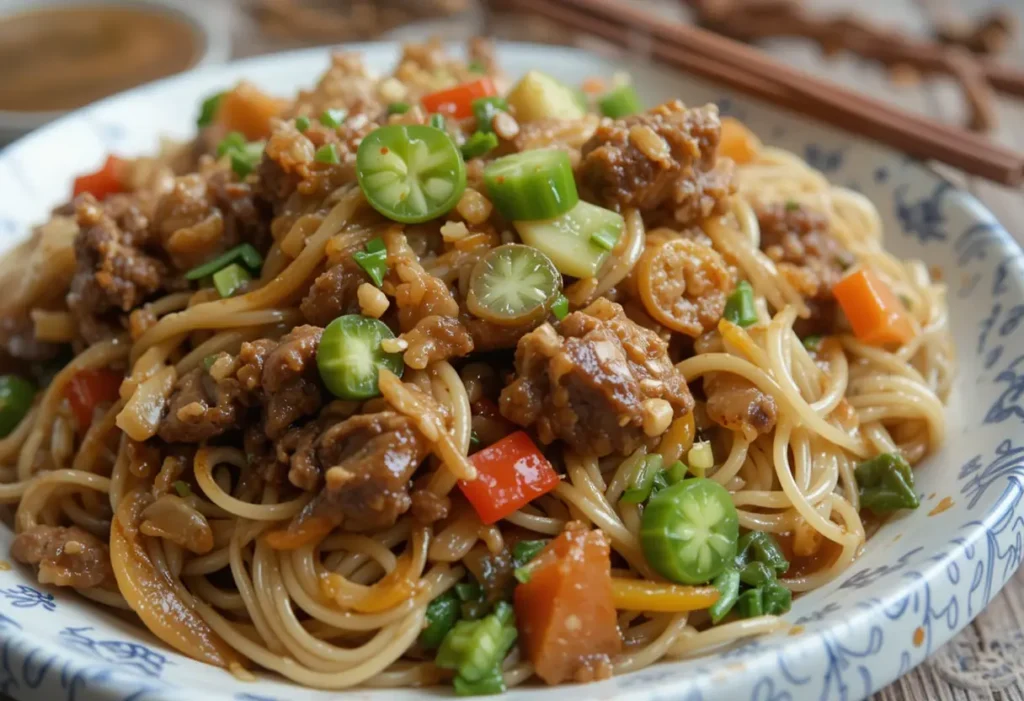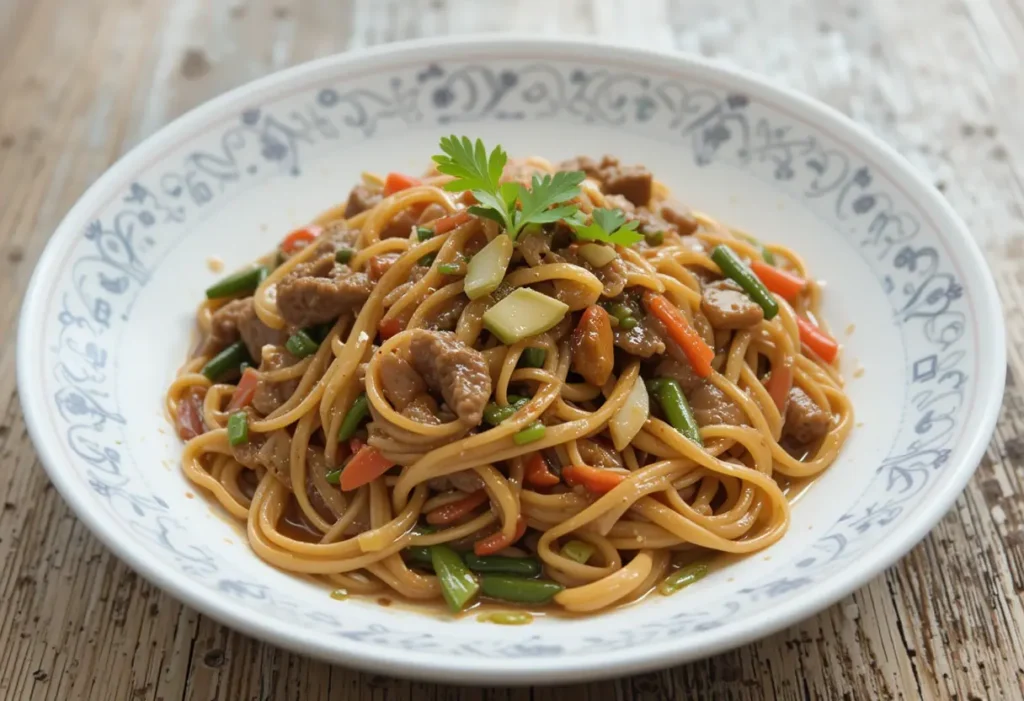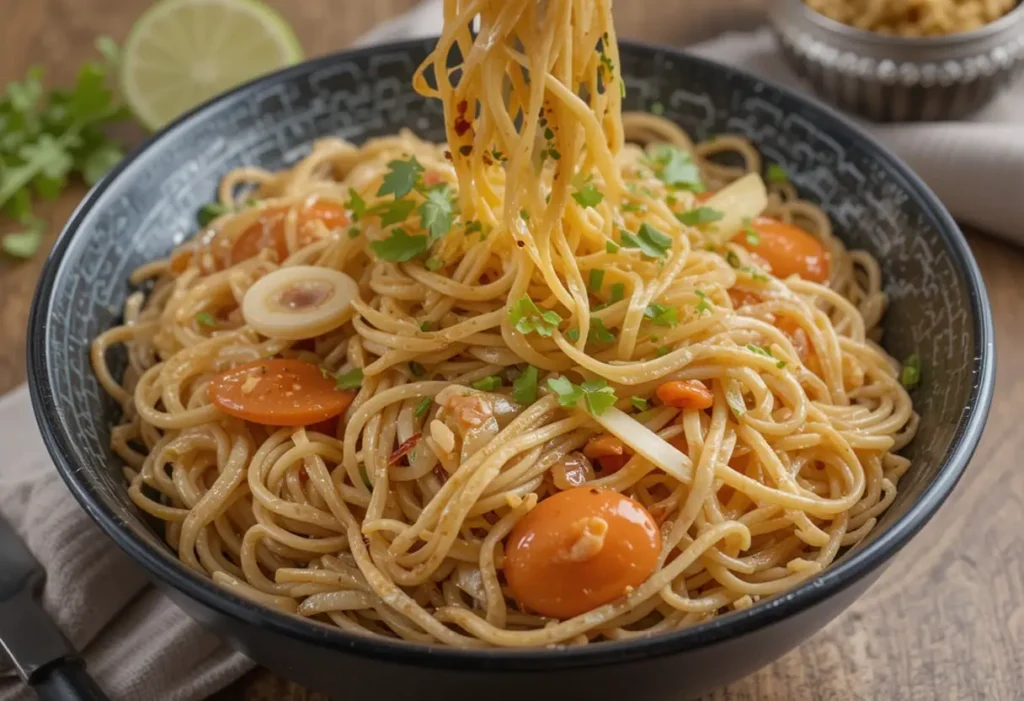Mongolian noodles are a cornerstone of the country’s robust and hearty cuisine. Known for their chewy texture and simple ingredients, these noodles are featured in various traditional dishes that highlight Mongolia’s nomadic heritage. But what exactly goes into making these noodles, and how do they stand apart from other Asian varieties? Let’s explore the history, ingredients, preparation methods, and popular dishes that make Mongolian noodles unique.
Introduction to Mongolian Noodles
In Mongolia, noodles represent more than just sustenance—they’re a symbol of community, heritage, and resourcefulness. Rooted in a cuisine shaped by the harsh climate and nomadic lifestyle, Mongolia noodles are designed to be hearty, simple, and nourishing. They are staples in dishes like soups, stir-fries, and dumplings, offering a versatile base that complements the rich, meaty flavors typical of Mongolian cooking.
Unlike the spicy, intricate profiles of other Asian cuisines, Mongolian dishes focus on simplicity, allowing the natural flavors of the ingredients to shine through.
History and Cultural Significance of Noodles in Mongolia
The tradition of noodle-making in Mongolia dates back centuries and is deeply tied to the country’s nomadic lifestyle and the influence of neighboring cultures like China and Russia. The expansion of the Mongolian Empire across Asia facilitated the exchange of culinary techniques, blending local traditions with foreign influences.
Interestingly, while Mongolian noodles are distinct, they share some similarities with their Chinese counterparts. To understand this better, check out the history of noodles in Asia, which offers a comprehensive look at how noodles have evolved across the continent.
In Mongolian households, noodles are more than a food item—they’re a centerpiece of family gatherings and celebrations. Their preparation is a skill passed down through generations, symbolizing both survival and hospitality. Dishes like Mongolian Beef Noodles showcase the perfect blend of rich flavors and chewy noodles that embody this heritage.

What Are Mongolian Noodles?
Mongolian noodles are known for their thick, chewy texture and rustic appearance. Unlike other Asian noodles, which might be delicate or thin, these noodles are cut by hand, giving them an irregular shape that adds to their charm.
Here’s what makes Mongolian noodles stand out:
- Texture: Thick and chewy, perfect for hearty dishes.
- Flavor: Mild, allowing the flavors of the accompanying meats and sauces to shine.
- Versatility: Used in a range of dishes from soups to stir-fries.
For a deeper dive into how these noodles are used in traditional recipes, explore this overview of Mongolian cuisine.
Core Ingredients of Mongolian Noodles
The simplicity of Mongolian noodles is one of their defining features. With just a few ingredients, these noodles are easy to make and highly adaptable.
Primary Ingredients:
- Wheat flour: The foundation of the noodle, providing structure and chewiness.
- Water: Helps bind the flour into a smooth, elastic dough.
- Salt: Adds a subtle flavor, enhancing the natural taste of the wheat.
Optional Ingredients:
- Egg: Adds richness and a slightly firmer texture.
- Buckwheat or barley flour: Used in some regions to create a nuttier flavor and darker color.
These basic ingredients come together to create a noodle that’s both sturdy and flavorful, perfect for absorbing rich sauces and broths.
Traditional Methods of Making Mongolian Noodles
The process of making Mongolian noodles is straightforward but requires attention to detail to achieve the perfect texture.
- Mixing the Dough: Combine wheat flour, water, and salt until the dough forms a cohesive ball.
- Kneading: The dough is kneaded thoroughly to develop gluten, which gives the noodles their characteristic chewiness.
- Rolling and Cutting: The dough is rolled out and cut into thick, hand-sized strips, creating the rustic, uneven appearance of traditional Mongolian noodles.
- Cooking: The noodles are either boiled, stir-fried, or added directly to soups.
This hands-on method reflects the resourcefulness of Mongolia’s nomadic people, who crafted nourishing meals with limited ingredients and tools.

Popular Mongolian Noodle Dishes
Mongolian noodles are the foundation of many beloved dishes, each showcasing the noodle’s versatility and ability to absorb rich flavors.
Tsuiwan (Mongolian Stir-Fried Noodles)
- Ingredients: Noodles, lamb or beef, onions, carrots, garlic, and soy sauce.
- Preparation: The noodles are stir-fried with thinly sliced meat and vegetables, creating a savory, satisfying dish.
- Cultural Significance: A common comfort food in Mongolian households, perfect for quick meals and family gatherings.
Lapsha (Mongolian Noodle Soup)
- Ingredients: Hand-cut noodles, lamb or beef, potatoes, and root vegetables.
- Preparation: The noodles are simmered in a rich broth, ideal for Mongolia’s cold winters.
Bansh (Dumplings with Noodles)
- Ingredients: Minced meat dumplings served alongside or within noodle dishes.
- Preparation: Combines the chewy texture of noodles with the savory taste of dumplings for a hearty, comforting meal.
For an exciting twist on traditional dishes, you can explore the origins of Mongolian Beef Noodles, a dish that combines the heartiness of Mongolian noodles with rich, flavorful beef.
Modern Variations and Fusion of Mongolian Noodles
While traditional recipes remain popular, Mongolian noodles have also been adapted to modern tastes, especially in urban areas. Fusion cuisine and global influences have introduced new ingredients and preparation methods.
- Western Fusion: Incorporating non-traditional ingredients like gluten-free flour or vegetarian proteins.
- Urban Street Food: Creative noodle dishes inspired by global flavors, such as spicy stir-fries with international sauces.
These adaptations maintain the integrity of traditional noodles while offering exciting new ways to enjoy them. To understand what makes Mongolian cuisine stand out globally, read more about what is special about Mongolian beef.
Nutritional Information of Mongolian Noodles
Mongolian noodles offer a balanced nutritional profile, making them both delicious and satisfying.
- Calories: Moderate, depending on the use of eggs or whole grains.
- Macronutrients: High in carbohydrates, with small amounts of protein from the flour and optional eggs.
- Health Benefits: Using whole-grain flours like buckwheat or barley increases fiber content and nutritional value. For more details, check out the benefits of whole wheat noodles.
How to Cook Mongolian Noodles at Home
Making Mongolian noodles at home is easier than you might think. Here’s a step-by-step guide:
- Prepare the Dough: Mix wheat flour, water, and salt until smooth.
- Knead the Dough: Knead for about 10 minutes to develop gluten.
- Roll and Cut: Roll out the dough and cut into thick strips.
- Cook: Boil the noodles for soups or stir-fry them with meats and vegetables.
Pro Tip: Use lamb for an authentic flavor and keep the seasoning simple to let the natural ingredients shine.
FAQs About Mongolian Noodles
1. What are Mongolian noodles made of?
Mongolian noodles are made from wheat flour, water, and salt. Some variations include egg or buckwheat flour for added richness.
2. Are Mongolian noodles gluten-free?
Traditional Mongolian noodles are not gluten-free since they are made from wheat flour. However, modern adaptations may use gluten-free flour.
3. How are Mongolian noodles different from Chinese noodles?
Mongolian noodles are thicker and chewier than Chinese noodles, reflecting the hearty, rustic style of Mongolian cuisine.
4. Can I make Mongolian noodles at home without special tools?
Yes! Mongolian noodles are traditionally hand-cut, so no special tools are required.
5. What is the most popular Mongolian noodle dish?
Tsuiwan, a stir-fried noodle dish with meat and vegetables, is one of the most beloved Mongolian noodle dishes.
Mongolian noodles are a delicious reflection of Mongolia’s rich culinary history. Whether you’re savoring a traditional bowl of Lapsha or experimenting with modern fusion dishes, these noodles offer a taste of Mongolia’s rugged charm and heritage.

